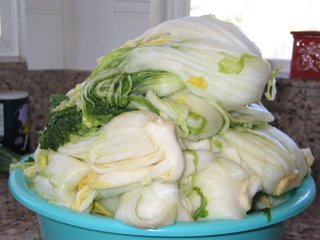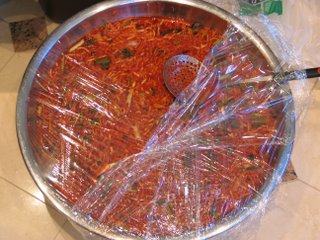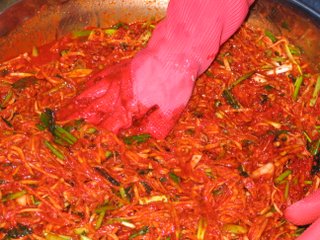 Acorn jelly with soy sauce
Acorn jelly with soy sauceDuring our first years in the US, it wasn't uncommon for my parents and folks of their generation and above to point out all the edible things that were growing along the roads when we were driving around. Sometimes, much to my and my sibling's deep chagrin - or utter horror - they would venture out to the side of the road when the road conditions permitted and start picking whatever it was that was edible. I remember one particular time when we stopped for mustard plants that were growing wild all over the side of the road. Sometimes, my cousins who had been born and raised in the US would joke, "There's our dinner," when we'd pass by shrubs or just plain weeds by the road. However, the humiliation of waiting for adults gathering food on the side of the road like desperate refugees didn't stop the young ones from enjoying the fruits of their labor. I myself am fond of steamed mustard plants seasoned with sesame oil and garlic.
I think of those adventures, which are now far and between, because my mother was making dotori mook, or acorn jelly, the other day. You could buy this from any of the Korean supermarkets in town but my mother rarely buys them prepared, ones that are most likely less than 100% acorn or natural. She prepares this when she's gotten acorns from somewhere - meaning, someone was industrious enough to gather enough acorns from who-knows-where to share with her. It helps that we live in California where there's an abundance of oak trees in certain areas and that Koreans aren't above picking up stuff from roads along which they may be taking a stroll.
The oak trees where my parents live produce acorns that are usually smaller and thinner than the ones in Korea but a careful observer can usually find one area where the acorns are big and fat. No doubt, it was from such a tree that a friend of my parents gathered enough acorns to share with them.
To me the most interesting part of using acorns as food is that acorns were a crucial part of California's Native American diet and Koreans and Native Americans share the same preparations to make acorns edible. I know this only anecdotally so I may be wrong about the details but it's interesting to note that our ancestors were equally resourceful on this one way of surviving.
To make the acorns edible, you'd have to peel and soak or soak and peel. I think soaking gets rid of some chemical that's poisonous. Tannin? Then you dry them and grind them to powder. To make the jelly, you mix the acorn powder with water and a pinch of salt and keep mixing in a pan over medium heat. You can add more water if you want your jelly very wobbly. You let it sit for a while until it hardens to a texture of jello. Unlike jello, you don't add gelatin or other artificial ingredients to make it firm.
It's a lot of work for something that tastes, frankly, not much. I don't mean it tastes bad. It just doesn't have any particular flavor that would wow you so that you'd remember. At least to me. To describe, its flavor is very subtle, slightly earthy with a hint of a bean-like flavor. You want to dress it with a bit of soy sauce mixture. But its texture is quite sublime, silky and smooth to rival the softest tofu out there.
Do-to-ri is pronounced extreme, fast staccato. My niece used to say "Doe-toe-rhee" to make fun of people who spoke Korean with an American English accent. That was our code for "funny." Now I've made it an open secret.









